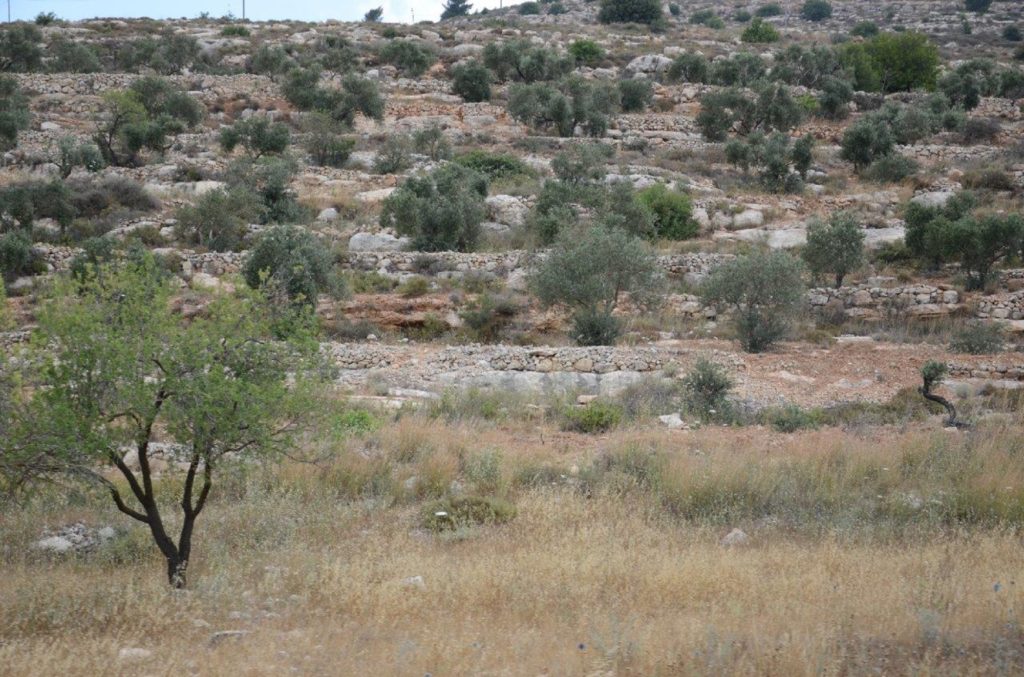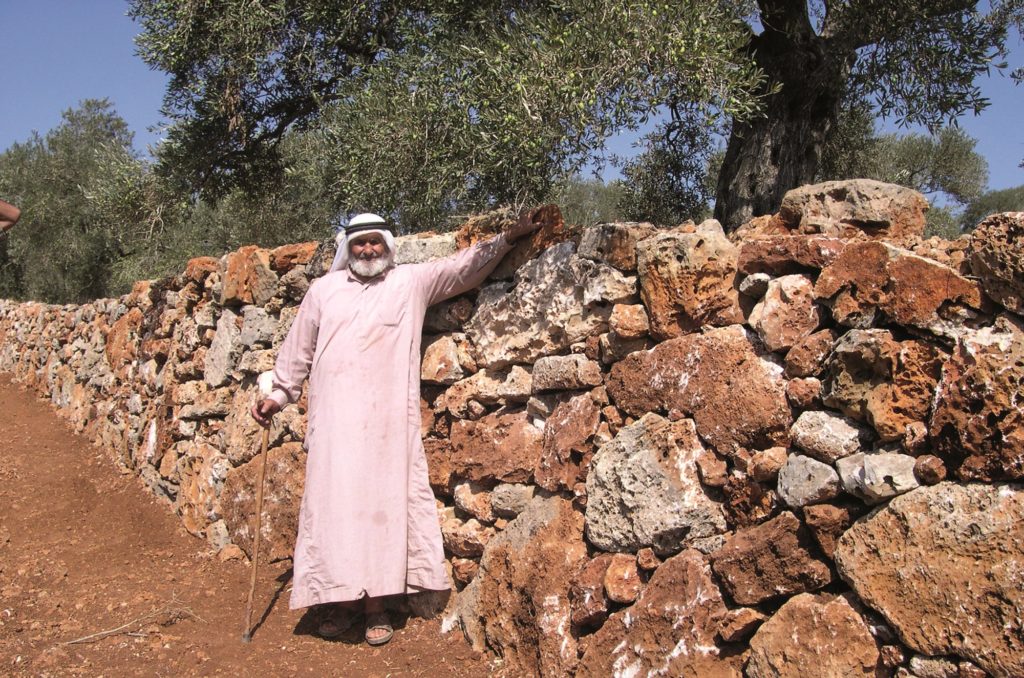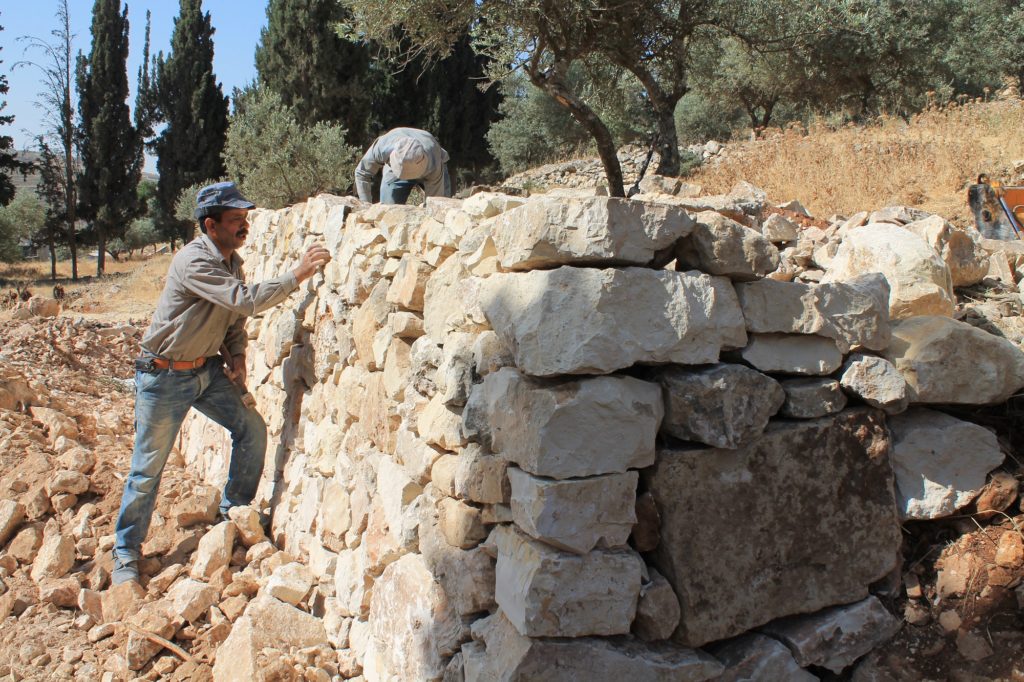Anera’s Land Reclamation Projects in Palestine Bolster Rural Communities
Posted in: Programs
Terrace walls are almost as ubiquitous as the olive trees that grow behind them on the arid hills of the West Bank. The crumbling remains of terraces cut by Roman farmers dot the landscape.
Driving along the steep road that leads from Qabalan to Jorish today, the role that terraces continue to play in conserving fertile land for farming is evident. In such mountainous terrain, terracing decreases erosion and surface runoff. In 2014, UNESCO recognized the cultural value of the stone terrace system dating back to antiquity by including the terraces in the West Bank village of Battir on its prestigious World Heritage List. The danger now is that the traditional knowledge of how to build terraces will be lost to future generations.


A quintessential West Bank scene — terraced hills and olive trees.
There is an art to building terraces. Farmers begin by using bulldozers to remove rocks and large stones from the ground. Then skilled terrace technicians re-purpose these stones to construct durable walls across the slopes in fields being reclaimed. The process revitalizes land owned by Palestinian families that had often laid idle for generations.
Terraced agricultural fields on steep hillsides conserve water and protect nutrient-rich soil from erosion. Farmers like to construct the walls from naturally existing stones, instead of concrete, as it is cheaper and at the same time permeable. The local stones allow water to flow out of the terraces during heavy rainfall to protect crops from flooding.
Along with reshaping the land, terracing also increases cultivation rates by protecting crops from grazing wild animals. Farmers take advantage of unique topography and use terraces as boundary markers between neighboring fields. Plants growing along outer wall boundaries look better and grow faster, as terraces conserve soil moisture and protect crops from strong winds. This phenomenon is known as the “edge effect.”


Old terrace wall in the town of Yatma, near Nablus.
Anera’s Work with Terracing
Anera pioneered land reclamation projects in Palestine in the 1980s and 1990s. During this period, the organization donated eight bulldozers and 300 pieces of new agricultural machinery to Palestinian farmers and farming cooperatives. We also helped two West Bank cooperatives capitalize on revolving credit funds to provide members with loans for land reclamation.
In the course of Anera’s 50-year history, we have supported many of the 184 West Bank farming cooperatives by providing training, loans, equipment, and other valuable assistance. In 2003 alone, we reclaimed 99 acres of hilly land in the southern West Bank, which helped farmers grow a variety of fruit trees. Fifteen years later, those orchards are well established and productive.
Even though farmers have been building terraces on hills in the Jordan Valley for millennia, there is a lack of trained terrace technicians today in Palestine. This traditional craft is in danger of vanishing as aging generations of farmers die. To meet the challenge over the years, Anera has sought out older farmers to mentor their younger peers in the necessary skills for successful terrace building.


Building a terrace for a park in Ramallah.
Between 2012 and 2014, Anera brought Palestinian farmers together to share their knowledge and expertise through films, conferences, and social media pages. For the program’s component on land reclamation, farmers from across Palestine came together to document in a video their indigenous knowledge about best practices for using reclaimed land. The film format makes it easy to share with other farmers and allows us to preserve the knowledge for generations to come.
The long-term impact of the terracing project is immediately evident in more than just farmland. Recently, I walked through the flowering terraces of Aqraba Public Park, enjoying the landscaping that Anera supervised and managed back in 2005. Large municipal parks — filled with colorful flowers, olive trees, playgrounds, and public fountains — are rare throughout the West Bank and provide valuable green spaces for children and the community to gather.
The benefits of terraces extend far beyond increasing the productivity of farms. When Palestinian farmers have the tools they need to nurture the land and cultivate their crops, their efforts not only revitalize agricultural land but entire communities. In parks and agricultural fields alike, terraces preserve a way of life for Palestinian families.
The author of this post, Naser Qadous, is Anera’s agricultural programs manager in the West Bank.
OUR BLOG
Related
In Gaza, systematic bombardment of civilian housing and infrastructure has created a crisis of shelter that is endangering over a million.
The undersigned members of the Association of International Development Agencies (AIDA) urgently call upon the international community to intervene and halt settler attacks targeting Palestinian civilians and protect Palestinian communities near illegal settlements. The International NGO Community urges international actors…
